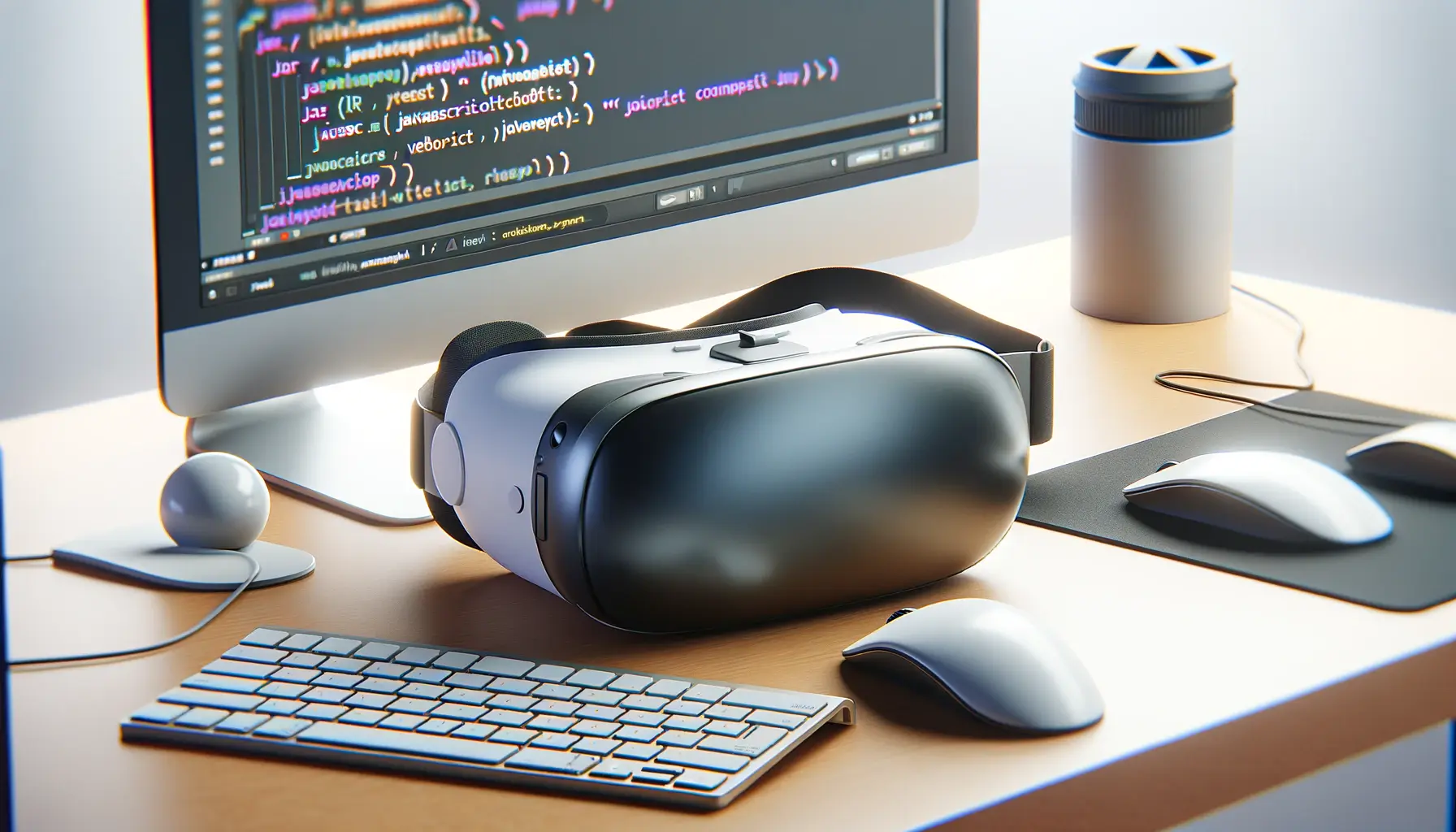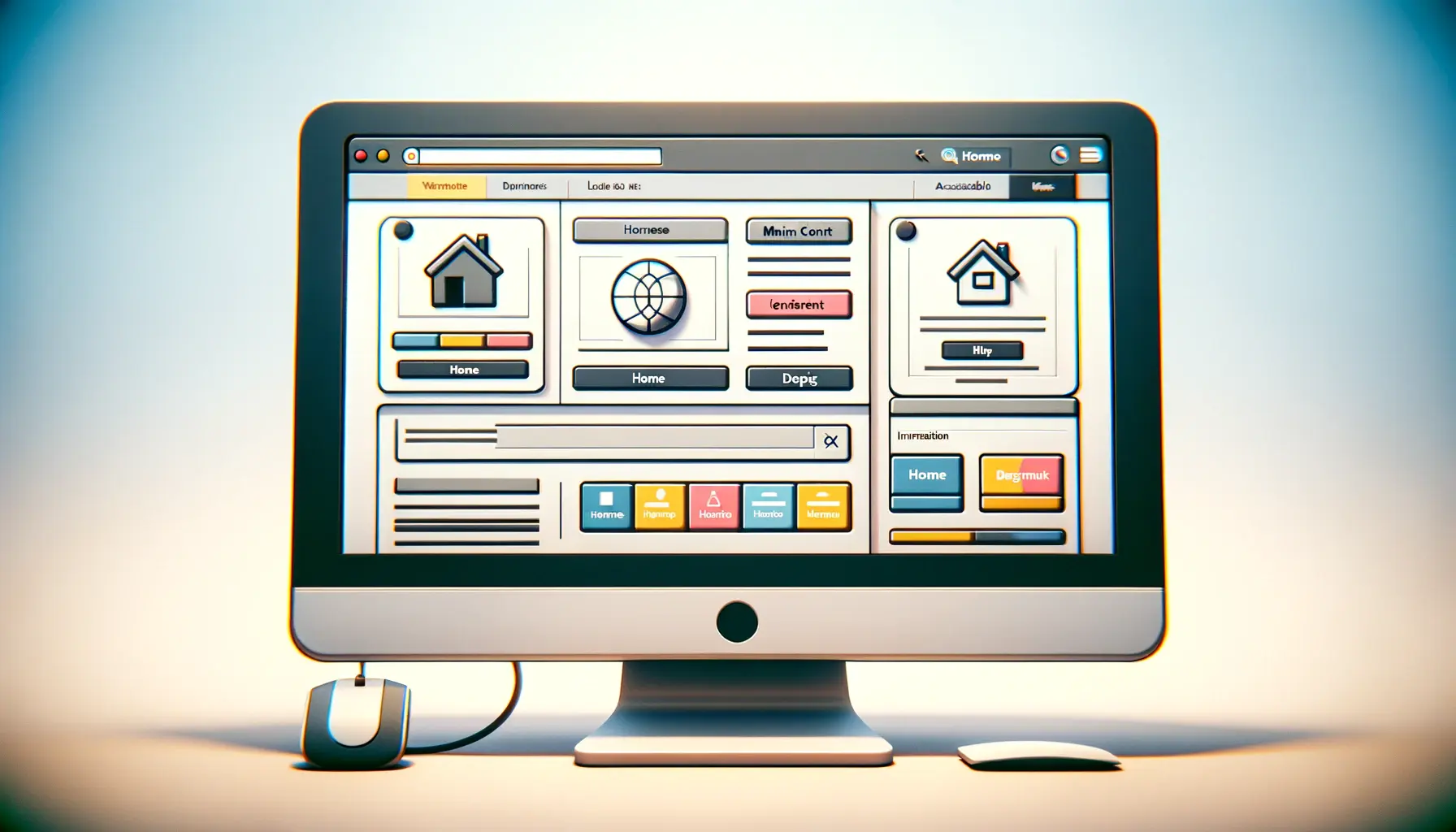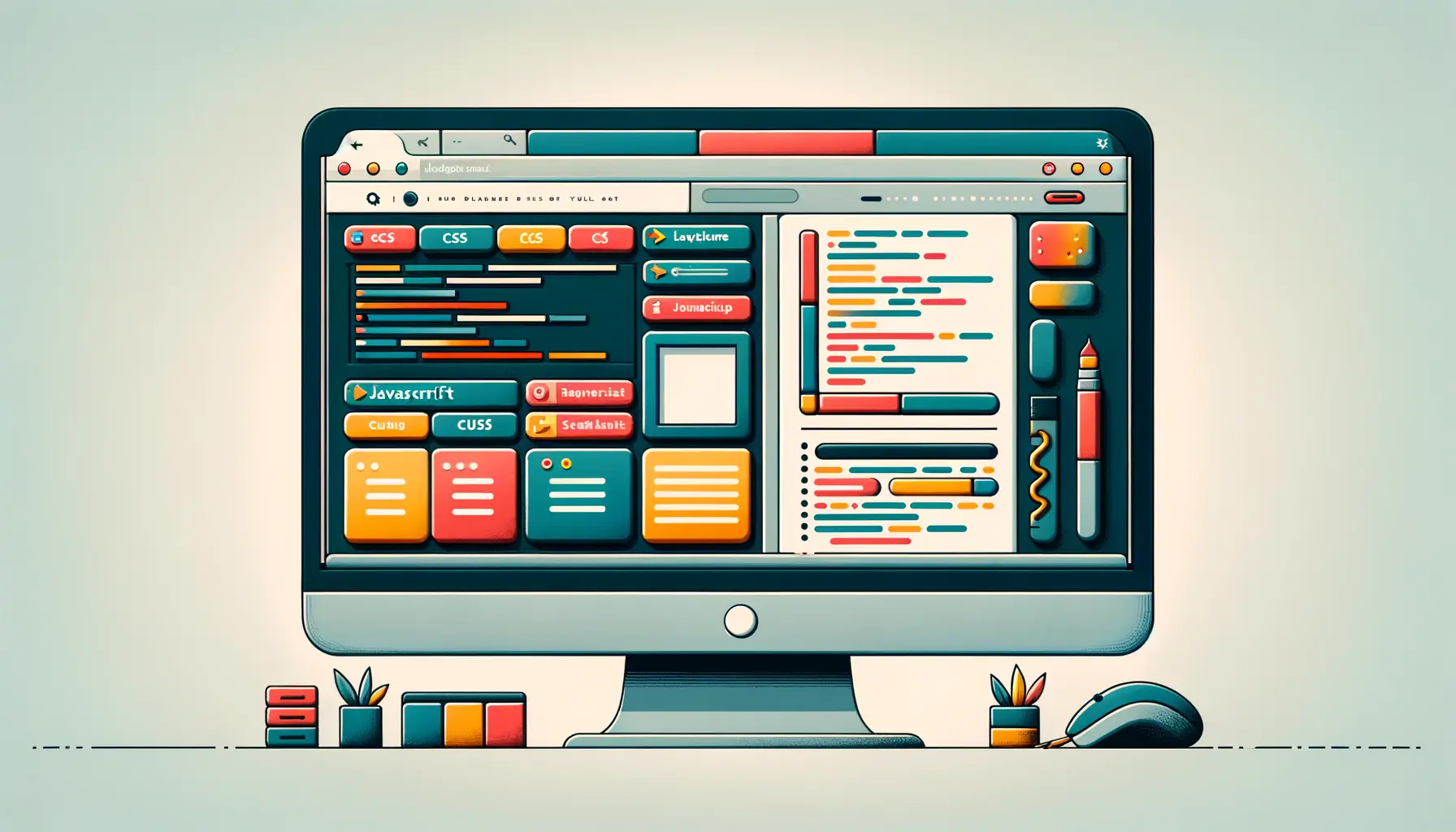The advent of Augmented Reality (AR) and Virtual Reality (VR) technologies has revolutionized the way we interact with digital environments, blending the physical and virtual worlds in unprecedented ways.
JavaScript, a language traditionally associated with web development, has emerged as a powerful tool for creating immersive AR/VR experiences.
This integration opens up a plethora of opportunities for developers and businesses alike, offering innovative ways to engage users and transform various industries.
With the rapid advancement of web technologies, JavaScript has evolved beyond simple web scripting to become the backbone of complex AR/VR applications.
The synergy between JavaScript and AR/VR technologies enables developers to craft interactive, three-dimensional experiences directly within web browsers, making these immersive environments more accessible to a wider audience.
This article delves into the intricacies of integrating AR/VR with JavaScript, exploring the tools, frameworks, and best practices that are shaping the future of immersive web experiences.
- Understanding AR/VR and JavaScript
- Key Technologies and Frameworks
- Developing AR/VR Experiences with JavaScript
- Challenges in AR/VR Development with JavaScript
- Best Practices for AR/VR Development in JavaScript
- Future Trends in AR/VR with JavaScript
- Integrating AR/VR in Various Industries
- Conclusion: The Future of AR/VR with JavaScript
- FAQs: Integrating AR/VR Technologies with JavaScript
Understanding AR/VR and JavaScript
What are AR and VR?
Augmented Reality (AR) enhances the real world by overlaying digital information onto it, whereas Virtual Reality (VR) creates a fully immersive digital environment that replaces the physical world.
Both technologies have seen significant growth, driven by advancements in computing power, graphics, and user interface design.
AR/VR applications span various sectors, including gaming, education, healthcare, and retail, offering enhanced user experiences and engagement.
The integration of AR/VR with JavaScript allows developers to utilize familiar web technologies to build and deploy immersive experiences.
This approach leverages the widespread availability of web browsers as platforms for AR/VR content, eliminating the need for specialized hardware or software installations.
JavaScript’s Role in AR/VR Development
JavaScript plays a crucial role in the development of web-based AR/VR applications.
Its versatility and support for event-driven, asynchronous programming make it well-suited for creating interactive 3D environments.
Libraries and frameworks such as Three.js, A-Frame, and React 360 extend JavaScript’s capabilities, providing developers with powerful tools to create complex AR/VR scenes with relative ease.
These tools abstract away the complexities of 3D graphics programming, allowing developers to focus on the creative aspects of AR/VR development.
With JavaScript, creating immersive experiences that run across various devices and platforms becomes more streamlined, making the technology accessible to a broader range of creators and audiences.
JavaScript’s evolution has positioned it as a key player in the AR/VR domain, enabling the creation of immersive, cross-platform experiences that were once the domain of specialized applications.
Key Technologies and Frameworks
The landscape of AR/VR development with JavaScript is rich and varied, with numerous libraries and frameworks designed to simplify the creation of immersive experiences.
These tools not only streamline the development process but also open up new possibilities for innovation and creativity.
Here, we explore some of the key technologies and frameworks that are pivotal in integrating AR/VR with JavaScript.
Three.js
At the forefront of 3D web graphics, Three.js stands out as a comprehensive library that simplifies WebGL’s complex processes.
It provides an intuitive API for creating and displaying animated 3D computer graphics in a web browser, without requiring the developer to have in-depth knowledge of WebGL itself.
Key features of Three.js include:
- Extensive geometry and material support, enabling the creation of complex 3D objects.
- Integrated animation functionalities, allowing for dynamic and interactive scenes.
- Compatibility with various loaders, making it possible to import 3D models from different software.
A-Frame
A-Frame is a web framework for building virtual reality experiences, making it exceptionally accessible for web developers familiar with HTML.
It abstracts away the complexities of VR development, allowing creators to build 3D, AR, and VR experiences with HTML-like syntax.
Highlights of A-Frame include:
- Entity-component system architecture, facilitating modular and reusable code.
- Integration with other web technologies, such as React, for enhanced interactivity.
- Extensive documentation and community support, easing the learning curve for newcomers.
React 360
React 360 leverages the popular React framework to create interactive 360-degree virtual experiences for web applications.
It is designed for the creation of user interfaces that allow users to navigate through immersive environments using familiar web technologies.
React 360’s strengths are:
- Efficient handling of 360-degree video and image content.
- Component-based development model, consistent with React’s design principles.
- Support for both 2D and 3D interfaces, enabling complex application designs.
Choosing the right framework or library depends on the specific requirements of the AR/VR project, including the level of interactivity, the complexity of the 3D models, and the target platform or devices.
Developing AR/VR Experiences with JavaScript
Creating AR/VR experiences with JavaScript involves more than just understanding the syntax and functionalities of libraries and frameworks.
It requires a holistic approach that encompasses design, user interaction, performance optimization, and cross-platform compatibility.
This section outlines the essential steps and considerations in the development process of AR/VR applications using JavaScript.
Designing Immersive Environments
The design of immersive environments is a critical first step in AR/VR development.
It involves conceptualizing the virtual space, defining user interactions, and creating a narrative or purpose for the experience.
Considerations include:
- User perspective and field of view: Ensuring that the environment is designed from the user’s viewpoint to enhance immersion.
- Interactivity: Defining how users will interact with the virtual environment and objects within it.
- Accessibility: Making the experience accessible to users with different abilities and ensuring it can be navigated intuitively.
Implementing User Interactions
User interaction is a cornerstone of engaging AR/VR experiences.
JavaScript developers can implement interactions such as gaze controls, hand tracking, and voice commands using various APIs and libraries.
Key aspects include:
- Event handling: Capturing and responding to user inputs through events like clicks, gazes, or gestures.
- Physics engines: Integrating physics engines to add realistic movements and collisions within the virtual environment.
- Feedback mechanisms: Providing users with visual, auditory, or haptic feedback to guide interactions and enhance realism.
Optimizing Performance
Performance optimization is crucial for maintaining smooth and responsive AR/VR experiences.
Developers must consider:
- Asset management: Optimizing 3D models, textures, and animations to reduce load times and improve rendering performance.
- Code efficiency: Writing efficient JavaScript code and leveraging best practices to minimize resource consumption.
- Testing and profiling: Regularly testing the application on target devices and using profiling tools to identify and address performance bottlenecks.
The development of AR/VR experiences with JavaScript is an iterative process that involves continuous testing, feedback, and refinement to ensure that the final product is engaging, intuitive, and performant.
Challenges in AR/VR Development with JavaScript
While JavaScript offers a versatile platform for AR/VR development, creators face several challenges that can impact the quality and performance of the final product.
Addressing these challenges requires a deep understanding of both the technical and user experience aspects of AR/VR development.
Handling Cross-Platform Compatibility
One of the primary challenges in AR/VR development is ensuring that experiences are accessible across a wide range of devices, including smartphones, tablets, and dedicated AR/VR headsets.
This involves:
- Adapting to different screen sizes and resolutions to ensure that visuals are clear and interfaces are usable.
- Accounting for varying levels of computational power, which can affect the complexity of the scenes and the smoothness of animations.
- Ensuring compatibility with different browsers and their respective versions, which may support different features and APIs.
Optimizing for Performance
Performance optimization is critical in AR/VR applications to prevent issues such as lag, low frame rates, and long loading times, which can significantly detract from the user experience.
Developers must focus on:
- Minimizing the size of assets and using efficient loading techniques to reduce initial load times and improve responsiveness.
- Implementing level-of-detail (LOD) techniques to dynamically adjust the complexity of 3D models based on the user’s distance, preserving performance without compromising visual quality.
- Utilizing web workers and asynchronous programming patterns to perform resource-intensive tasks without blocking the main thread, ensuring a smooth user experience.
Enhancing User Interaction and Engagement
Creating intuitive and engaging user interactions in AR/VR environments poses unique challenges, particularly when translating physical actions into digital responses.
Developers need to:
- Design interaction models that are natural and intuitive, leveraging gestures, voice commands, and gaze controls effectively.
- Provide clear feedback and guidance to users, helping them understand possible interactions and the effects of their actions within the virtual environment.
- Explore innovative ways to enhance immersion, such as incorporating haptic feedback or integrating real-world objects into the virtual experience.
Assuming that AR/VR development with JavaScript is straightforward can lead to underestimating the complexity and nuances of creating immersive experiences that are both performant and engaging.
Best Practices for AR/VR Development in JavaScript
To overcome the challenges associated with AR/VR development using JavaScript and to ensure the creation of high-quality immersive experiences, developers should adhere to a set of best practices.
These guidelines not only help in optimizing performance but also in enhancing user engagement and interaction.
Focus on User Experience Design
At the heart of any successful AR/VR application lies a well-thought-out user experience (UX) design.
Best practices in UX design for AR/VR include:
- Keeping interfaces simple and intuitive to minimize user confusion and cognitive load.
- Designing for accessibility, ensuring that the application is usable by people with a wide range of abilities.
- Conducting user testing early and often to gather feedback and identify areas for improvement.
Optimize Content and Assets
Content optimization is crucial for maintaining high performance and a smooth user experience.
Developers should:
- Compress textures and models without significantly compromising visual quality.
- Implement lazy loading and progressive rendering techniques to load content as needed, reducing initial load times.
- Use asset bundling and minification to reduce the number of HTTP requests and the size of JavaScript files.
Leverage the Latest Web Technologies
Staying updated with the latest advancements in web technologies can provide developers with new tools and methods to enhance AR/VR experiences.
This includes:
- Exploring new APIs and features introduced in the latest versions of web standards and browsers.
- Incorporating WebXR for more immersive and interactive AR/VR experiences that take full advantage of device capabilities.
- Using WebAssembly for performance-critical components to achieve near-native execution speeds.
Ensure Cross-Platform Compatibility
Given the diverse ecosystem of devices capable of running AR/VR applications, ensuring cross-platform compatibility is essential.
This involves:
- Testing the application on a variety of devices, operating systems, and browsers to identify and resolve compatibility issues.
- Adapting user interfaces and controls to accommodate different input methods, such as touchscreens, controllers, and keyboard/mouse setups.
- Using responsive design techniques to ensure that the application adjusts gracefully to different screen sizes and aspect ratios.
Adhering to these best practices can significantly improve the quality and performance of AR/VR applications developed with JavaScript, leading to more engaging and immersive user experiences.
Future Trends in AR/VR with JavaScript
The AR/VR landscape is continuously evolving, with new technologies and trends emerging that shape the way we create and interact with immersive experiences.
JavaScript, being at the forefront of web development, plays a pivotal role in adopting and implementing these innovations.
Here, we explore some of the future trends in AR/VR development with JavaScript that are expected to influence the industry.
Increased Adoption of WebXR
WebXR is set to become the standard for creating immersive web experiences, offering unified support for AR and VR across browsers and devices.
Its adoption will enable developers to:
- Build more sophisticated and interactive AR/VR experiences directly within the web browser, without the need for external applications or plugins.
- Access device capabilities such as spatial tracking, environmental understanding, and hand gesture recognition, enhancing the realism and interactivity of virtual environments.
Advancements in Real-time Collaboration
As remote work and virtual meetings become more prevalent, AR/VR technologies offer innovative ways to collaborate and communicate.
Future developments in JavaScript-based AR/VR applications will likely focus on:
- Enabling real-time collaboration in virtual spaces, allowing users to interact with each other and shared content in a more immersive and engaging manner.
- Integrating AR/VR experiences with existing communication platforms and productivity tools, blurring the lines between physical and virtual workspaces.
Integration with Artificial Intelligence
Artificial Intelligence (AI) and Machine Learning (ML) are set to play a significant role in enhancing AR/VR experiences.
By integrating AI with JavaScript-based AR/VR applications, developers can:
- Implement intelligent object recognition and interaction, enabling more natural and intuitive user experiences.
- Create adaptive and personalized virtual environments that respond to user behavior and preferences.
Expanding Accessibility and Inclusivity
As AR/VR technologies become more mainstream, ensuring accessibility and inclusivity will be paramount.
Future trends include:
- Developing tools and guidelines for creating AR/VR experiences that are accessible to users with disabilities, including those with visual, auditory, and mobility impairments.
- Promoting diversity and inclusivity in virtual environments, ensuring that all users feel represented and welcome.
The future of AR/VR with JavaScript is bright, with emerging trends focusing on enhancing interactivity, collaboration, and accessibility. As these technologies continue to evolve, they will offer new opportunities for creating immersive and inclusive virtual experiences.
Integrating AR/VR in Various Industries
The versatility of AR/VR technologies, combined with the accessibility of JavaScript, has opened up new avenues for their application across various industries.
These immersive technologies are not just transforming entertainment and gaming but are also making significant inroads into education, healthcare, real estate, and more.
This section highlights the impact of integrating AR/VR with JavaScript in different sectors.
Revolutionizing Education and Training
AR/VR technologies are redefining educational methodologies and training programs by providing immersive learning experiences that enhance understanding and retention.
Applications include:
- Virtual field trips that allow students to explore distant or inaccessible locations.
- Interactive simulations for complex subjects like anatomy, physics, and engineering, offering hands-on learning without the risks associated with real-world experiments.
- Soft skills training through virtual scenarios that mimic real-life interactions, improving communication, leadership, and decision-making skills.
Transforming Healthcare Services
In the healthcare sector, AR/VR applications developed with JavaScript are facilitating medical training, patient treatment, and rehabilitation.
Key innovations include:
- Virtual reality simulations for surgical training, enabling medical professionals to practice procedures in a risk-free environment.
- Augmented reality overlays that assist surgeons during operations by providing real-time data and 3D visualizations of the patient’s anatomy.
- VR-based therapy for treating conditions such as PTSD, anxiety, and phobias, offering controlled environments for exposure therapy.
Enhancing Real Estate and Architecture
AR/VR technologies are revolutionizing the real estate and architecture industries by enabling virtual tours, property previews, and architectural visualization.
Benefits include:
- Virtual property tours that allow potential buyers to explore properties remotely, saving time and resources.
- Augmented reality applications that enable users to visualize furniture and decor in their own homes before making a purchase.
- Architectural visualization tools that help architects and clients preview designs in 3D, facilitating better communication and decision-making.
Advancing Retail and E-commerce
AR/VR technologies are also transforming the retail and e-commerce sectors by enhancing the shopping experience and enabling personalized customer engagement.
Innovations include:
- Virtual try-on solutions that allow customers to visualize clothes, accessories, or makeup on themselves before making a purchase.
- AR-enabled shopping apps that provide product information, reviews, and comparisons by simply pointing a smartphone camera at a product or its barcode.
- Virtual showrooms and stores that offer an immersive shopping experience, combining the convenience of online shopping with the engagement of in-store visits.
The integration of AR/VR with JavaScript is not only enhancing user experiences across various industries but is also driving innovation, efficiency, and accessibility in ways previously unimagined.
Conclusion: The Future of AR/VR with JavaScript
The integration of AR/VR technologies with JavaScript has ushered in a new era of digital experiences, transforming the way we interact with the world around us.
From immersive educational programs to innovative healthcare solutions, AR/VR applications are making significant impacts across various industries.
The accessibility and flexibility of JavaScript as a development platform have played a pivotal role in this transformation, enabling developers to create complex, interactive experiences with relative ease.
Empowering Developers and Creators
JavaScript’s evolution into a powerful tool for AR/VR development has democratized the creation of immersive experiences, empowering developers and creators with diverse skill sets.
The availability of robust frameworks and libraries, such as Three.js, A-Frame, and React 360, has lowered the barrier to entry, making it possible for more people to contribute to the AR/VR landscape.
This democratization is fostering innovation and creativity, leading to the development of applications that were once thought impossible.
Enhancing User Experiences
At the heart of AR/VR technologies is the aim to enhance user experiences, whether it’s by providing more engaging learning environments, improving patient care, or revolutionizing the retail experience.
The integration with JavaScript has enabled these technologies to become more accessible and widespread, reaching a broader audience.
As AR/VR devices become more affordable and web standards such as WebXR continue to evolve, we can expect these immersive experiences to become an integral part of our daily lives.
Looking Ahead
The future of AR/VR with JavaScript is bright, with continuous advancements in web technologies driving further innovation.
As we look ahead, several trends are likely to shape the development of AR/VR applications:
- The increasing adoption of WebXR will provide a unified platform for creating immersive experiences, further blurring the lines between reality and the digital world.
- Real-time collaboration and social interaction within AR/VR environments will become more prevalent, opening up new possibilities for remote work, education, and entertainment.
- Advancements in AI and machine learning will enable more personalized and adaptive AR/VR experiences, enhancing user engagement and satisfaction.
In conclusion, the integration of AR/VR with JavaScript is not just a technological achievement; it’s a gateway to new forms of interaction, learning, and entertainment.
As developers continue to explore the possibilities of these technologies, we can expect to see even more innovative applications that will enrich our lives in countless ways.
The journey of AR/VR with JavaScript is just beginning, and the potential for what lies ahead is truly limitless.
Quality web design is key for a great website! Check out our service page to partner with an expert web design agency.
FAQs: Integrating AR/VR Technologies with JavaScript
Explore common questions about leveraging JavaScript for creating immersive augmented reality (AR) and virtual reality (VR) experiences.
Yes, JavaScript is widely used for AR/VR development, especially with libraries like Three.js, A-Frame, and React 360 that simplify creating immersive experiences.
A-Frame is a web framework for building virtual reality (VR) experiences using HTML-like syntax, making VR development accessible to web developers.
Three.js is a 3D library that simplifies WebGL programming, enabling developers to create detailed 3D graphics and immersive AR/VR experiences in web browsers.
React 360 is designed for creating interactive 360-degree virtual experiences, making it a powerful tool for VR projects that require user interaction.
While JavaScript-based AR/VR experiences are highly versatile, their performance and compatibility may vary across different devices and browsers.
Challenges include ensuring cross-platform compatibility, optimizing performance for complex scenes, and creating intuitive user interactions.
WebXR is crucial for developing unified AR/VR experiences on the web, offering standardized APIs for interacting with VR and AR hardware.
Yes, developers should consider accessibility in AR/VR by designing experiences that are inclusive and usable for people with various abilities.












